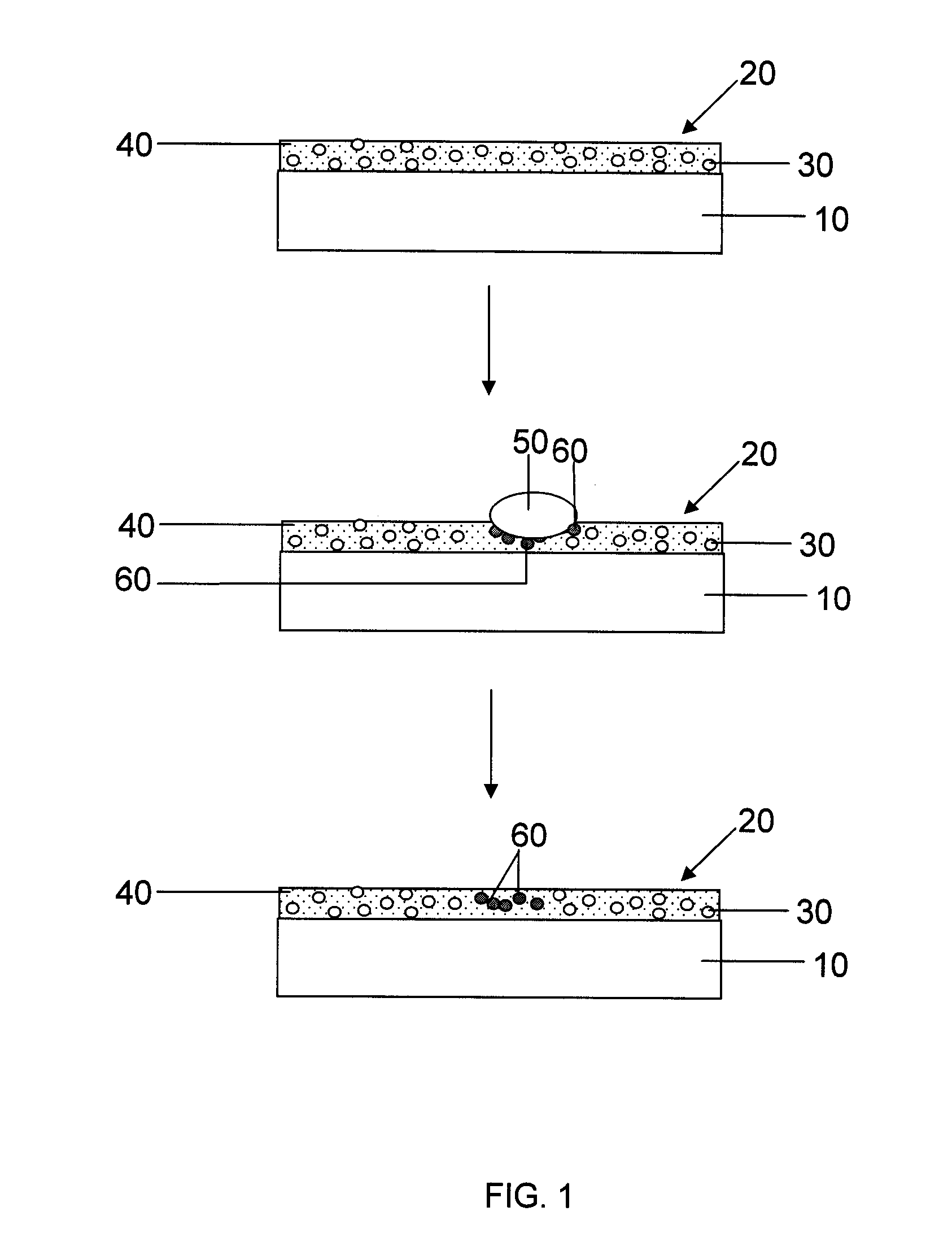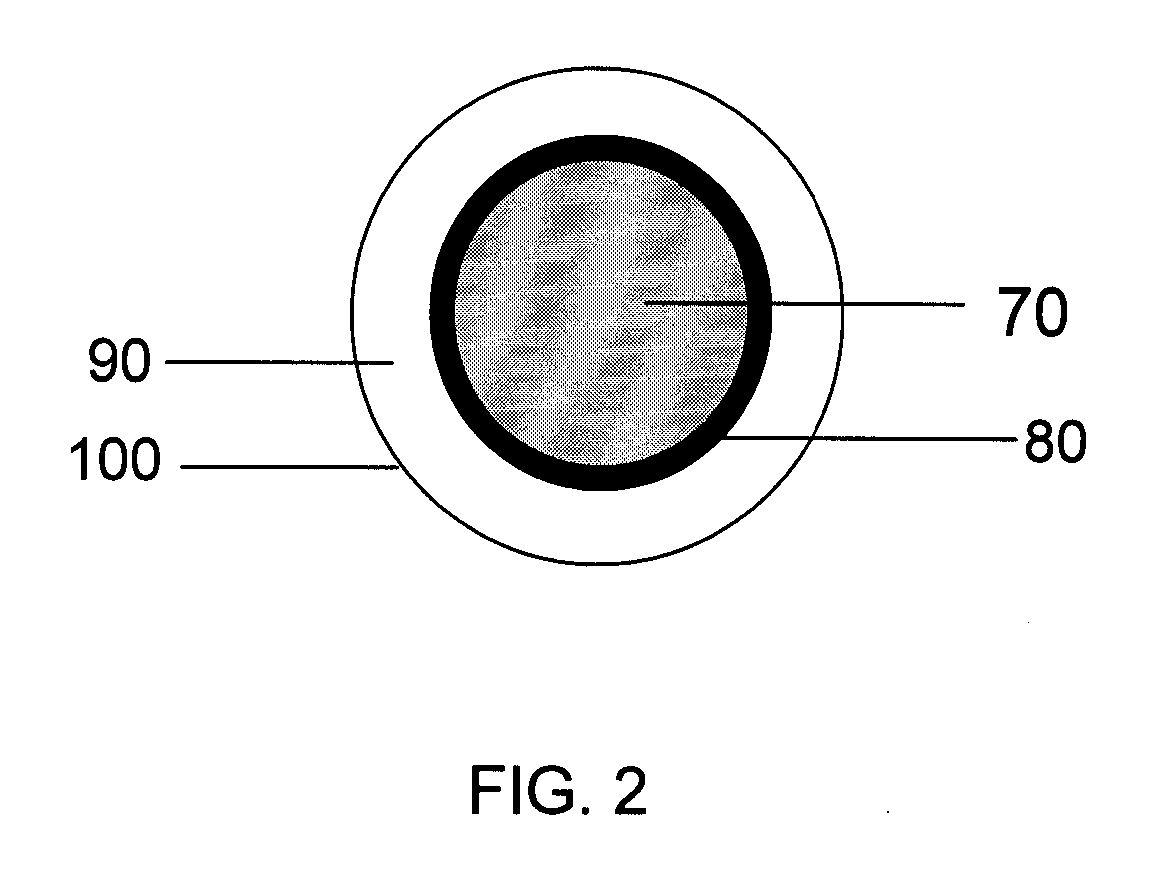Method for Detecting Damage
a technology of damage detection and damage detection, applied in the direction of measuring value by color change, instruments, structural/machine measurement, etc., can solve the problem that the pressure sensitive material on which it is placed loses one or more of its inherent physical properties
- Summary
- Abstract
- Description
- Claims
- Application Information
AI Technical Summary
Benefits of technology
Problems solved by technology
Method used
Image
Examples
example 1
[0033] Dye filled microcapsules, known as HRJ 13944, HRJ 14893, and HRJ 14894, commercially available from Schenectady International, Incorporated, were blended with color developers (or activators), known as HRJ 4023 and HRJ 14508 also commercially available from Schenectady International, Incorporated, and mixed with a paint known as Solucote 1073 commercially available from Soluol, Inc., according to the amounts shown in Table 1. The impact indicator paints were cast at 1-3 mils (0.001-0.003″) onto a coated panel, using a drawdown blade. A Universal Impact Tester (Gardco Model 173) was used to evaluate the impact indicator paint. A 2 lb standard weight was dropped from a measured distance through a tube to impact the coated panel. A ¼″ diameter ball point was used at the end of the 2 lb weight to focus the energy on the coated panel (used for evaluating flexibility and impact properties of coatings). The change in intensity of coloration was observable by eye. The intensity of co...
example 2
[0034] Dye microcapsules and activators were incorporated into a waterborne latex paint with the amounts described in Table 2. Substrates were coated and tested as described in Example 1. The impact color change was designated on a scale from 0-5 (0—no change; 5—high change of color at any impact level). The change in intensity of coloration was readily observable by the eye.
TABLE 2Details of Microcapsule / Latex FormulationsColorDye MicrocapsulesActivatorChangeSam-HRJHRJHRJHRJHRJPaintwithple139441489314894402314508LatexImpact152A0.25g0.5 g9.25 g 1152B0.5g0.5 g 9 g2152C0.75g0.5 g8.75 g 2152D1g0.5 g8.5 g3152E1.250.5 g8.25 g 3152F1.50.5 g 8 g4152G1g0.25 g 8.75 g 2152H1g0.5 g8.5 g3152I1g0.75 g 8.25 g 3152J1g 1 g 8 g4152K1 g0.5 g8.5 g1152L1 g0.5 g8.5 g2152M1 g0.5 g8.5 g1152N1 g0.5 g8.5 g1152O1g0.5 g8.5 g3152P1g0.5 g8.5 g3
example 3
[0035] Microspheres and activators were incorporated into an anionic waterborne polyurethane dispersion. Table 3 provides examples of these formulations and impact results. Substrates were coated and tested as described in Example 1. The impact color change was designated on a scale from 0-5 (0 —no change; 5—high change of color at any impact level).
TABLE 3Details of Microcapsule / Polyurethane FormulationsDyeMicrocapsulesActivatorPaintHRJHRJAnionicColor Change withSample148944023PhenolPUDImpact157A0.5 g0.5 g9 g1157B 1 g 1 g8 g3157C0.5 g0.5 g9 g1157D 1 g 1 g8 g4
PUM
| Property | Measurement | Unit |
|---|---|---|
| weight | aaaaa | aaaaa |
| pressure sensitive | aaaaa | aaaaa |
| pressure | aaaaa | aaaaa |
Abstract
Description
Claims
Application Information
 Login to View More
Login to View More - R&D
- Intellectual Property
- Life Sciences
- Materials
- Tech Scout
- Unparalleled Data Quality
- Higher Quality Content
- 60% Fewer Hallucinations
Browse by: Latest US Patents, China's latest patents, Technical Efficacy Thesaurus, Application Domain, Technology Topic, Popular Technical Reports.
© 2025 PatSnap. All rights reserved.Legal|Privacy policy|Modern Slavery Act Transparency Statement|Sitemap|About US| Contact US: help@patsnap.com


